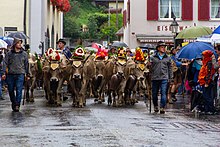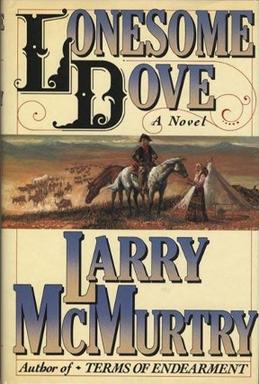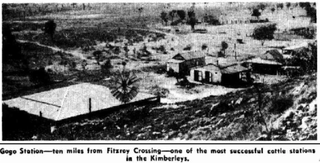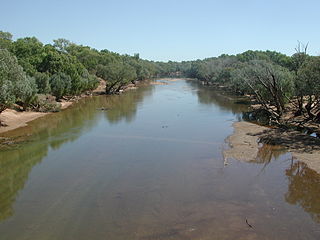
A cattle drive is the process of moving a herd of cattle from one place to another, usually moved and herded by cowboys on horses.

A cattle drive is the process of moving a herd of cattle from one place to another, usually moved and herded by cowboys on horses.

In medieval central Europe, annual cattle drives brought Hungarian Grey cattle across the Danube River to the beef markets of Western Europe. [1] In the 16th century the Swiss operated cattle drives over the St. Gotthard Pass to the markets in Bellinzona and Lugano and into Lombardy in northern Italy. The drives had ended by 1700 when sedentary dairy farming proved more profitable.[ citation needed ] In the eighteenth century up to 80,000 cattle were driven South from Scotland each year. From 1850 cattle trains were established from Aberdeen to London. [2]
Australia is noted for long drives. Patsy Durack, for instance, left Queensland for the Kimberley in Western Australia in 1885 with 8,000 cattle, arriving with only half that number some two years and two months later, completing a drive of some 3,000 miles. Indeed, long cattle drives continued well into the latter half of the twentieth century. [3]
On March 26, 1883 two Scottish/Australian families, the MacDonalds and the McKenzies, began a huge cattle drive from Clifford's Creek near Goulburn, New South Wales to the Kimberley, where they established "Fossil Downs" station. The journey of over 6,000 km lasted more than three years and involved Charles ('Charlie') MacDonald (1851–1903) and William Neil ('Willie') MacDonald (1860–1910), sons of Donald MacDonald from Broadford on the Isle of Skye (who had sailed from Scotland in the 1830s). The family moved to Clifford's Creek, Laggan, and the brothers had become expert bushmen. The cattle drive was undertaken after Donald MacDonald heard glowing reports of the Kimberley from Scots/Australian explorer Alexander Forrest in 1879. The MacDonalds and the McKenzies formed a joint venture to obtain leases in the Kimberley and to stock them by overlanding the cattle. The brothers were joined by their cousins Alexander and Donald MacKenzie, Peter Thomson, James McGeorge and Jasper Pickles. They set out with 670 cattle, 32 bullocks yoked to two wagons and 86 horses. All foodstuffs and equipment for the long journey were carried in the wagons. Drought conditions delayed progress and most of the original party, apart from Charlie and Willie MacDonald, withdrew long before Cooper's Creek was reached. Stock losses were replaced, only to be reduced again by the continued drought. Despite a grueling journey through crocodile- and mosquito-infested territory in the top end with frequent Aboriginal attacks, the cattle eventually arrived at the junction of the Margaret and Fitzroy Rivers in July 1886 and "Fossil Downs" station was established. It is the longest cattle drive in history. [4] [5]

Cattle drives involved cowboys on horseback moving herds of cattle long distances to market. Cattle drives were at one time a major economic activity in the American West, particularly between the years 1866-1895, when 10 million cattle were herded from Texas to railheads in Kansas for shipments to stockyards in Chicago and points east. Drives usually took place in Texas on the Goodnight-Loving Trail (1866), Potter-Bacon trail (1883), Western trail (1874), Chisholm Trail (1867) and Shawnee Trail (1840s).
Due to the extensive treatment of cattle drives in fiction and film, the cowboy tending to a herd of cattle has become the worldwide iconic image of the American West.

A cowboy is an animal herder who tends cattle on ranches in North America, traditionally on horseback, and often performs a multitude of other ranch-related tasks. Cattle drives ensure the herds health in finding pasture and bring them to market. The historic American cowboy of the late 19th century arose from the vaquero traditions of northern Mexico and became a figure of special significance and legend. A subtype, called a wrangler, specifically tends the horses used to work cattle. In addition to ranch work, some cowboys work for or participate in rodeos. Cowgirls, first defined as such in the late 19th century, had a less-well documented historical role, but in the modern world work at identical tasks and have obtained considerable respect for their achievements. Cattle handlers in many other parts of the world, particularly South America and stockmen and jackaroos in Australia, perform work similar to the cowboy.

Lonesome Dove is a 1985 Western novel by American writer Larry McMurtry. It is the first published book of the Lonesome Dove series and the third installment in the series chronologically. It was a bestseller and won the 1986 Pulitzer Prize for Fiction. In 1989, it was adapted as a TV miniseries starring Tommy Lee Jones and Robert Duvall, which won both critical and popular acclaim. McMurtry went on to write a sequel, Streets of Laredo (1993), and two prequels, Dead Man's Walk (1995) and Comanche Moon (1997), all of which were also adapted as TV series.

The Chisholm Trail was a trail used in the post-Civil War era to drive cattle overland from ranches in Texas to Kansas railheads. The trail was established by Black Beaver, a Lenape guide and rancher, and his friend Jesse Chisholm, a Cherokee merchant. They collected and drove numerous cattle along the trail to Kansas, where they could be shipped east to achieve higher prices. The southern terminus was Red River Station, a trading post near the Red River along the northern border of Texas. The northern terminus was a trading post near Kansas City, Kansas. Chisholm owned both of these posts. In the years of the cattle drives, cowboys drove large herds from ranches across Texas to the Red River Station and then north to Kansas City.

In Australia and New Zealand, a cattle station is a large farm, the main activity of which is the rearing of cattle. The owner of a cattle station is called a grazier. The largest cattle station in the world is Anna Creek Station in South Australia, which covers an area of 23,677 square kilometres.

A drover in Australia is a person, typically an experienced stockman, who moves livestock, usually sheep, cattle, and horses "on the hoof" over long distances. Reasons for droving may include: delivering animals to a new owner's property, taking animals to market, or moving animals during a drought in search of better feed and/or water or in search of a yard to work on the livestock. The drovers who covered very long distances to open up new country were known as "overlanders".

The Shire of Derby–West Kimberley is one of four local government areas in the Kimberley region of northern Western Australia, covering an area of 104,080 square kilometres (40,186 sq mi), most of which is sparsely populated. The Shire's population as at the 2016 Census was almost 8,000, with most residing in the major towns of Derby, which is also the Shire's seat of government, and Fitzroy Crossing. There are also around 70 Aboriginal communities within the Shire.

Droving is the practice of walking livestock over long distances. It is a type of herding. Droving stock to market—usually on foot and often with the aid of dogs—has a very long history in the Old World. An owner might entrust an agent to deliver stock to market and bring back the proceeds. There has been droving since people in cities found it necessary to source food from distant supplies.

Cattle drives were a major economic activity in the 19th and early 20th century American West, particularly between 1850s and 1910s. In this period, 27 million cattle were driven from Texas to railheads in Kansas, for shipment to stockyards in St. Louis and points east, and direct to Chicago. The long distances covered, the need for periodic rests by riders and animals, and the establishment of railheads led to the development of "cow towns" across the frontier.

The Great Western Cattle Trail is the name used today for a cattle trail established during the late 19th century for moving beef stock and horses to markets in eastern and northern states. It is also known as the Western Trail, Fort Griffin Trail, Dodge City Trail, Northern Trail and Texas Trail. It ran west of and roughly parallel to the better known Chisholm Trail into Kansas, reaching an additional major railhead there for shipping beef to Chicago, or longhorns and horses continuing on further north by trail to stock open-range ranches in the Dakotas, Wyoming, Montana, and two provinces in Canada. A full-length drive from the trailhead south of Bandera, Texas took almost one hundred days to reach its destination in Kansas.

Fossil Downs Station is a pastoral lease and cattle station located about 50 kilometres (31 mi) north east of Fitzroy Crossing in the Kimberley region of Western Australia.

Home Valley or Home Valley Station is a pastoral lease and cattle station in Western Australia.

The Spring Creek raid, also known as the Tensleep Murders or the Tensleep Raid, occurred in 1909 and was the last serious conflict during the Sheep Wars in Wyoming, as well as the deadliest sheep raid in the state's history. On the night of April 2, the sheepherder Joe Allemand and four of his associates were encamped along Spring Creek, near the town of Ten Sleep, when a group of seven masked cattlemen attacked them. It remains uncertain as to whether or not an exchange of gunfire took place between the two parties, but evidence suggests that Allemand and two of his men were executed while the remaining two escaped unharmed. Two sheep wagons were also destroyed by fire and about two dozen head of sheep were shot to death. Seven men were arrested for the crime, two of whom turned state's evidence and were acquitted. The rest were found guilty and sent to prison for sentences ranging from three years to life in prison. The conviction of the Tensleep murderers effectively put an end to the killings on the open range and exemplified the arrival of law and order in a region that still retained its rugged frontier environment after the end of the 19th century. Although there continued to be sheep raids in Wyoming into the 1910s, there were no more deaths.

Gogo or Gogo Station and sometimes referred to as Margaret Downs is a pastoral lease that has operated as a cattle station. It is located about 11 kilometres (7 mi) south of Fitzroy Crossing and 83 kilometres (52 mi) north east of Yungngora in the Kimberley region of Western Australia.

Brunette Downs Station, mostly referred to as Brunette Downs, is a pastoral lease operating as a cattle station in the Northern Territory of Australia.

Wave Hill Station, most commonly referred to as Wave Hill, is a pastoral lease in the Northern Territory operating as a cattle station. The property is best known as the scene of the Wave Hill walk-off, a strike by Indigenous Australian workers for better pay and conditions, which in turn was an important influence on Aboriginal land rights in Australia.

Yeeda Station is a pastoral lease that operates as a cattle station in the Kimberley region of Western Australia.

Cherrabun or Cherrabun Station is a pastoral lease that once operated as a sheep station but presently operates as a cattle station in Western Australia.
Liveringa or Liveringa Station, often referred to as Upper Liveringa Station, is a pastoral lease in Western Australia that once operated as a sheep station but presently operates as a cattle station.
Glenroy Station is a pastoral lease that operates as a cattle station in Western Australia.
Donald MacDonald mostly known as Dan MacDonald was a prominent Australian pastoralist.